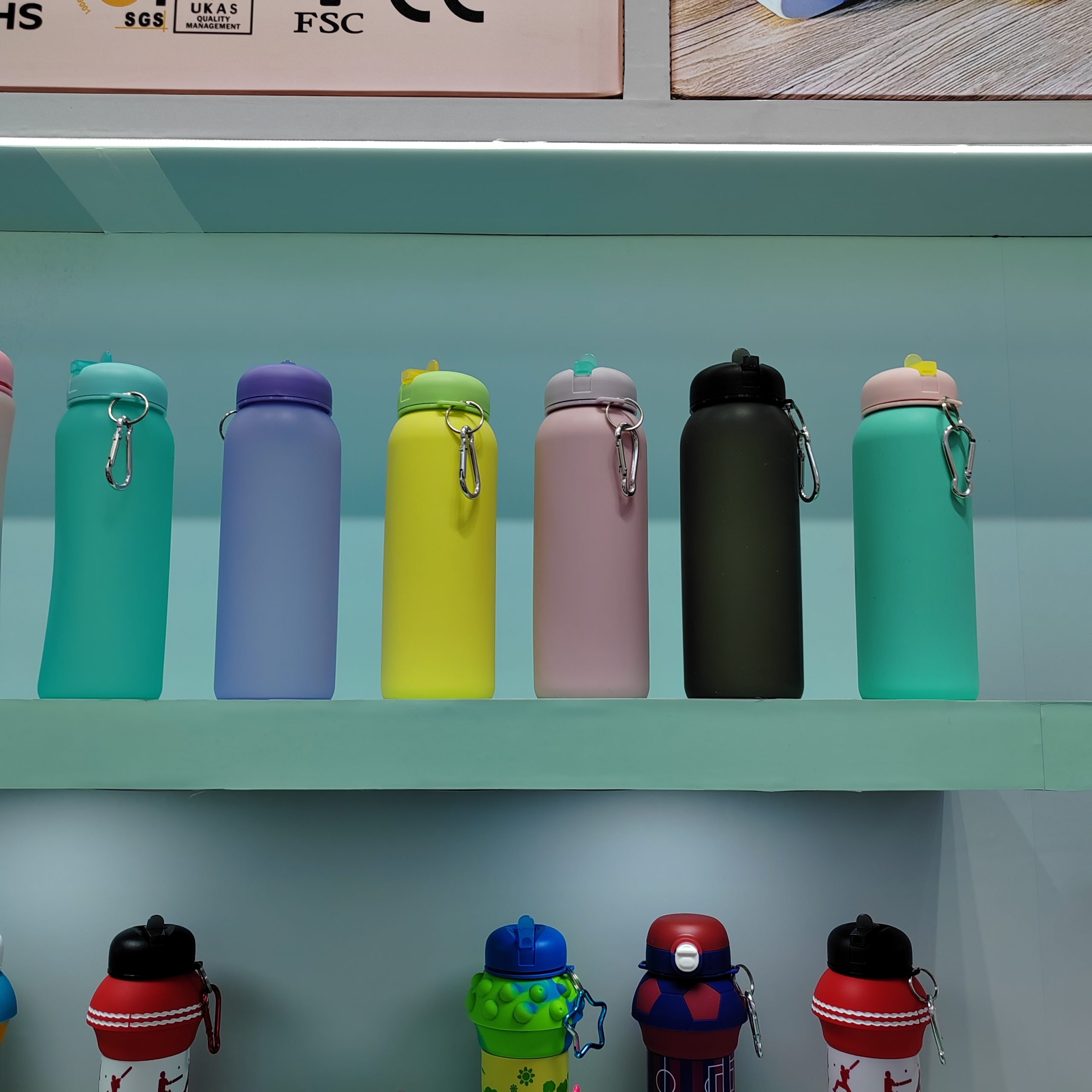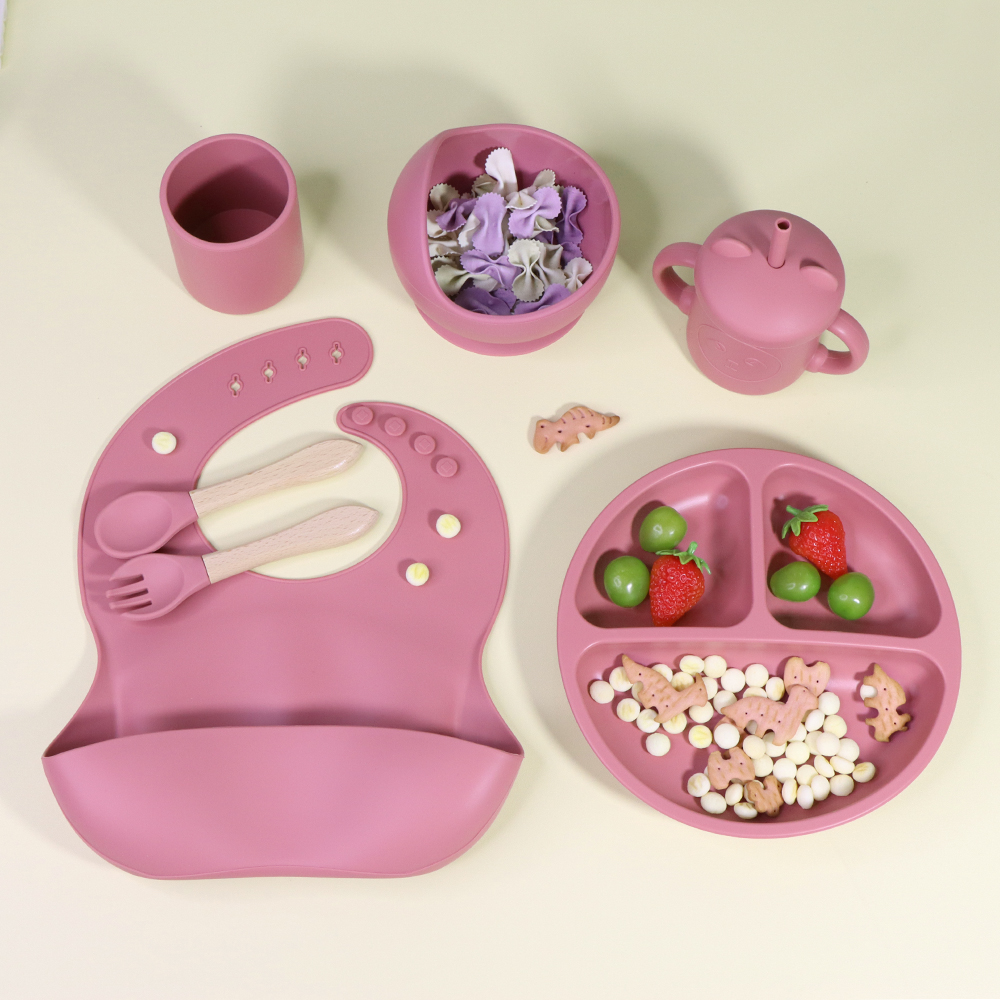目录
导言:了解有机硅产品制造的基础知识
我们的目标是让您熟悉硅胶行业的基本术语。通过提高您的知识水平,我们希望您能够在硅胶水瓶、硅胶饭盒和硅胶模具等硅胶产品方面做出明智的决定。作为一家领先的硅胶工厂,我们专注于提供高质量的定制硅胶产品,以满足批发客户的需求。
![]()
材料透视:硅胶与硅
硅是一种合成聚合物,经常与天然元素硅混淆。硅是元素周期表中的第 14 种元素,也是地壳中含量第二高的元素。它与氧结合后形成硅酸盐,是许多矿物的基础。另一方面,有机硅是由硅氧烷聚合而成的,硅氧烷是由硅原子和氧原子交替组成的链,通常由有机基团修饰。这种区别在有机硅产品制造中至关重要,因为这两种材料的特性差别很大。
![]()
聚合和交联
在硅胶产品制造过程中,硅胶的制造涉及两个关键步骤:聚合和交联。在聚合过程中,硅氧烷单体连接在一起,形成长而柔韧的聚合物链。然后通过过氧化物固化或铂固化进行交联,从而形成三维网络,赋予有机硅独特的弹性和耐用特性。选择过氧化物固化还是铂固化取决于所需的最终性能和监管要求,如 FDA 或 LFGB 标准,由于铂固化有机硅纯度高且无副产品,因此监管要求通常更倾向于铂固化有机硅。
用于制造的有机硅类型
- LSR(液态硅橡胶)
适用于要求高精度和光滑表面的产品,例如我们的硅胶水瓶。LSR 可以在较低的温度下进行加工,从而加快了生产周期,并能进行更复杂的设计。

- HCR(高一致性橡胶)
适用于需要较厚壁和坚固结构的应用,如我们的硅胶饭盒。HCR 通常用于压缩和传递成型工艺。
- RTV(室温硫化)
RTV 常用于 DIY 和小型项目,可在室温下固化,方便原型制作和维修。
- FSR(氟硅橡胶)
具有更强的耐燃料和耐溶剂性,适用于恶劣环境中的特殊应用,但通常不用于我们的消费品。
- 沉淀白炭黑
可用作增强填料,改善有机硅的机械性能,通常与 LSR 和 HCR 配合使用,以提高强度和耐用性。
- 气相法二氧化硅
作为一种增稠剂,它能提高液态硅酮体系的粘度,有助于 LSR 的加工,并确保在模具内的均匀分布。
固化方法和合规性
- 过氧化物固化
考虑到成本效益,符合 FDA 标准的产品通常使用过氧化物固化,而不是铂固化。过氧化物固化涉及使用过氧化物作为引发剂,过氧化物分解后会形成自由基并引发交联。它可以满足 FDA 测试的要求,即 21 CFR 第 177 部分,其中规定了与食品接触的聚合物的要求,包括不超过萃取测试中提取的化学物质的最大允许量。
- 铂固化(添加固化)
使用铂基催化剂,固化过程更清洁、更稳定,不会产生副产品。由于这种方法符合食品级和医疗级应用所要求的严格安全和质量标准,因此通常是符合 LFGB 标准的首选方法。
FDA 和 LFGB 要求
– FDA(美国食品和药物管理局)标准:注重不含有害物质和安全添加剂。铂金固化硅胶因其纯度高,更有可能符合美国食品及药物管理局的标准,尤其是对于硅胶水瓶和饭盒等与食物接触的物品。
– LFGB(Lebensmittel-, Bedarfsgegenstände- und Futtermittelgesetzbuch)标准:与美国食品和药物管理局(FDA)类似,LFGB 也要求材料不含有害物质,对人体健康无害。同样,铂固化有机硅因其纯度高、无副产品而受到青睐,确保其通过食品接触材料的严格测试。
硫化和后固化的作用
- 硫化工艺及其重要性
这一工艺包括在有固化剂存在的情况下加热硅胶,使聚合物链之间形成交联。它赋予硅胶强度、弹性和热稳定性,对最终产品的耐用性和性能至关重要。
- 后固化:二次热处理
在初始硫化后,通常会进行后硫化,以进一步改善硅胶的物理性能。这种二次热处理有助于去除任何残留的挥发性化合物,提高交联密度,并达到特定应用所需的最佳机械和化学特性。
硅胶产品制造中的成型方法
- 注塑成型
是大批量生产复杂形状产品的理想选择。由于 LSR 粘度低,能够填充复杂的模具,因此常用于这一工艺中,是我们硅胶水瓶的完美选择。
- 压缩成型
适用于精度要求不高的大型简单部件。HCR 经常用于压缩成型,如我们生产的硅胶饭盒。
- 转印模塑
这是一种生产带嵌入件或复杂几何形状零件的多功能方法。根据产品的具体要求,LSR 和 HCR 均可使用。
- 液体注射成型(LIM)
结合了注塑和压缩成型的优点,具有出色的表面光洁度和尺寸精度。LSR 是 LIM 中使用的主要材料,可确保零件的高质量和精确度。
- 挤压
最适用于管材和带材等连续型材,可生产一致、均匀的产品。RTV 和 FSR 可用于挤压,但 LSR 也可用于生产更专业的挤压产品。
材料特性和设计考虑因素
– 拉伸强度:决定材料在断裂前所能承受的最大应力。例如,我们水瓶中使用的 LSR 具有很高的拉伸强度,可确保经久耐用。
– 抗撕裂性:表示材料的抗撕裂能力。我们的午餐盒使用的 HCR 具有出色的抗撕裂性。
– 压缩套件:测量压缩后的永久变形。这对长期保持产品的形状和功能非常重要。
– 硬度(邵氏 A):影响最终产品的手感和柔韧性。我们的 硅胶产品 设计有特定的硬度级别,以确保舒适性和可用性。
– 导热性:对于需要散热的应用非常重要。我们的硅胶产品,尤其是厨房用具中使用的硅胶产品,可承受的温度范围很广。
– 耐化学性:确保产品在各种环境下的耐用性。FSR 虽然不用于我们的消费品,但它是一种具有优异耐化学性的硅胶。
硅胶产品制造中的设计要素
– 分界线:对模具设计至关重要,会影响最终产品的外观和功能。在我们的硅胶水瓶和饭盒中,分模线都经过精心设计,以尽量减少明显的接缝,确保光滑、专业的表面效果。
– 闪光灯:管理分模线上可能出现的多余材料,确保整洁、专业的表面效果。我们采用先进的成型技术,最大限度地减少飞边,确保产品达到最高质量标准。
– 粘度控制:对于确保模具的流动性和填充性至关重要,会影响到制成品的整体质量和一致性。对粘度的精确控制至关重要,尤其是在 LSR 和 HCR 工艺中,可使我们的硅胶产品达到理想的厚度和均匀性。
通过深入探讨硅胶产品制造的这些方面,我们希望提供一个全面的概述,突出我们硅胶工厂的专业知识和能力,为我们尊贵的批发合作伙伴提供一流的定制硅胶产品。




